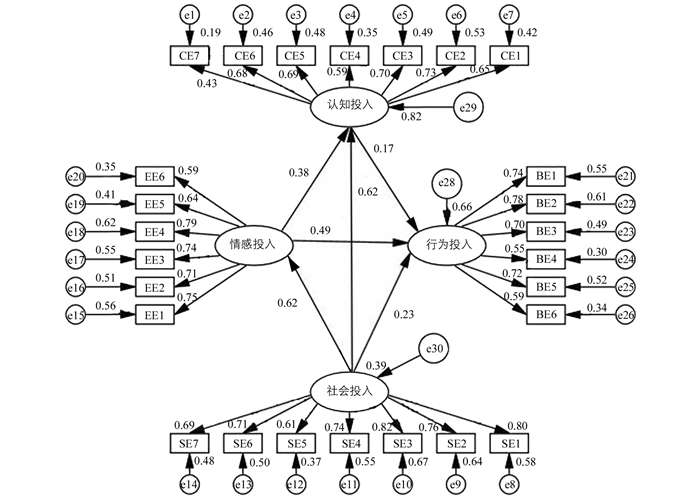-
近年来,在学习心理研究领域,越来越多的学者开始关注和研究学生的学习投入. 一般而言,学习投入并不是一个单一维度的结构,而是一个具有多维度结构的概念,包含了对学生的学习行为、心理过程以及社会环境的理解[1]. 在已有的学习投入研究中,研究者一般将学习投入结构划分为行为投入、认知投入和情感投入,这也是学习投入结构要素最为经典的划分[2]. 然而,具体到特定学科如数学学科的学习中,学生在数学学习的投入就不仅仅体现在“知、情、行”上,学生所在的学习群体和环境亦会对其数学学习产生深远的影响. 最近,文献[3]将社交领域的投入视为学生数学课堂学习的组成部分. 在社交活动中享有乐趣,受到重视并觉得自己有能力的学生更有可能争取他人的支持来完成学习任务;同时想要与同伴建立积极关系的学生也更有可能获得较高的数学学习成绩[3]. 从这个意义上讲,社会投入也理应是学生数学学习投入的关键要素.
总的来说,数学学习投入是指学生在进行数学学习时,积极投身于学习活动之中以及与同伴保持互动时所体现出的持续的积极状态. 教育研究者针对不同背景下学习投入与学生数学学业成就和个体学习质量的关系进行了一系列的实证研究,发现学习投入是衡量数学学业成就和个体学习质量的有效指标[4]. 还有研究者从相关理论和实践探索的角度出发,对数学学习投入进行了分析与评测[5].
然而,整理相关文献发现,对学习投入结构要素的研究主要包含简单的描述性分析、相关分析以及多元回归分析,仅仅表明各结构要素间的简单线性关系. 特别地,具体到数学学科背景下,更是缺乏对数学学习投入各结构要素之间的复杂结构关系进行的研究和分析. 针对这一现状,本研究借鉴已有的学习投入研究成果,通过结构方程模型构建并测量数学学习投入的结构模型,从而阐述数学学习投入各结构要素之间的结构关系及其对总体数学学习投入产生的作用效应,以期为改善学生学习投入与教育服务质量提供有利支撑.
全文HTML
-
本研究将数学学习投入结构划分为行为投入、认知投入、情感投入和社会投入,建立中学生数学学习投入结构的模型(见图 1),并提出研究假设.
-
行为投入是指学生在学习活动中的行为表现,包括努力程度和参与学习活动的强度等[6],也有学者将其定义为专注力、时间投入、学生完成作业情况和遵守课堂规则等方面[7]. 因此,本研究将其界定为学生积极参与数学课堂活动和完成学校布置的数学任务的情况. 例如“在学习数学时,我能一直保持专注”等. 行为投入是学习投入的一种外显表征,同时也是情感投入、认知投入和社会投入的重要载体[8].
-
认知投入主要是指学生在学习数学时为了实现既定学习目标,提高学习效率和效果,从而采用相应的方法与策略,主要包括认知策略以及在学习活动中监控的元认知策略[9]. 例如“我会仔细检查所完成的数学功课来确保它们的准确性”等.
学生在数学学习的行为表现在某种程度上来说受其认知水平高低的影响. 当学生在学习数学的过程中具有较高的认知投入水平时,他们往往会倾向于运用深层次认知策略,同时也具有强烈的求知心态,积极主动地思考各种数学难题;而当学生在学习数学的过程中具有较低认知投入水平时,他们会表现出机械式地记忆数学知识点和数学公式等浅层次投入[10]. 即学生采取不同的认知投入会有不同的行为投入. 因此,本研究基于上述背景提出假设H1:数学学习认知投入会显著影响数学学习行为投入
-
情感投入主要是指学生在学习时所流露出的兴趣爱好、所感受到的学习价值和情感体验. 一般而言,当学生在学习过程中有较高情感投入时,他们会表现得积极主动,并且会带有积极的情感体验,如好奇心和高兴. 相反地,当学生在学习过程中情感投入度不高时,他们的学习行为将会变得十分被动,且带有如忧虑和愤怒等悲观的情绪[11]. 本研究认为情感投入主要是学生在数学学习过程中体验到学习的价值,主要表现为学生对数学课堂的情绪反应,包括兴趣、快乐和焦虑. 例如“我期待上数学课”等.
情感是学生在学习活动中产生的内心体验,不但直接影响学生的学习行为及其学业成就,而且对学生的认知发展也起着决定性的作用. 文献[3]表明:情感投入是行为投入和认知投入的先决条件,喜欢学习的学生会更多地参与课堂活动,并对自己的学习有更多的自主权,情感投入为学生认知和行为过程的发展奠定了基础. 学生学业情绪和情感体验影响学生在学习活动中的自愿性或自主性,不同的学习情绪会促使学生采取不同的学习行为,进而影响个体的学习行为表现[12]. 同时情感投入也有助于学习者对学习任务进行深层次的认知加工[13]. 因此本研究基于上述背景提出以下两种假设:H2:数学学习情感投入会显著正向影响数学学习行为投入;H3:数学学习情感投入会显著正向影响数学学习认知投入.
-
一些学者基于社交互动的质量,围绕课堂任务投入度的社会形式定义增加了另一维度,即社会投入. 社会投入主要是指学生与同龄人之间的日常社交活动,这些活动与教学内容息息相关[14-15]. 数学课堂上的社会投入质量可以影响学生在数学学科上的成就,尤其是在以改革为基础的数学课堂上,学生有广泛的机会在小组中学习,分享自己的想法和学习心得[16]. 本研究将社会投入界定为学习者与同伴之间的社会互动,如同伴之间的反馈交流、作业互评以及资源与经验的分享等. 例如“我会和其他同学一起交流数学学习”等.
一般而言,学生在学习过程中的社会投入会对其行为投入产生积极影响. 先前有关研究表明,学生与其他同学之间的交流与讨论对其学习成绩有直接影响,也能够更有效率地促进双方完成课堂任务[17].
同时,良好的社会投入可以改善学生在数学学习过程中所产生的厌倦感,也能逐渐改善学生的学习投入和提高学生的学习效果. 已有研究表明:学生个体主动为同学进行学习上的帮助(例如答疑解惑),有利于学生之间建立平等友好的关系,而平等友好的同伴关系能够使学习者在情感上感到舒适,进而在数学学习上投入更多情感,即便是简单的合作交流也能够对学习者的情感支持产生积极的影响[18].
此外,学生之间的社会投入通常以互动的方式进行,反映学生的批判性思维、协作知识建构等认知投入,对促进学生的认知投入大有益处[19]. 学者在探讨学习投入对学习成就的影响机制中发现,良好的同伴关系会促进学生使用更加深层的学习方式,从而提高学习成绩. 同伴之间的合作交流能够促进智力和认知发展,其原因是在合作互动中学生会使用高阶学习策略,如详细阐述、综合监控和批判性思维. 因此基于上述分析,本研究认为存在以下两种假设,即H4:数学学习社会投入会显著正向影响数学学习行为投入;H5:数学学习社会投入会显著正向影响数学学习情感投入;H6:数学学习社会投入会显著正向影响数学学习认知投入.
1.1. 行为投入
1.2. 认知投入
1.3. 情感投入
1.4. 社会投入
-
本研究在广西、四川、河南、湖北、重庆8所中学发放1 600份调查问卷,回收有效问卷1 512份,有效回收率为94.5%,其具体信息如表 1.
-
结合文献[3, 20]编制的数学学习投入问卷,自编了中学生数学学习投入问卷共计66道题目. 本研究在调查之前在重庆某所中学发放了800份问卷,经过验证性因素分析发现某些项目的载荷较小,同时经过探索性因素分析发现某些项目存在较严重的交叉载荷,最终确定中学生数学学习投入问卷测试题目. 行为投入6道,认知投入7道,情感投入6道,社会投入7道,共计26道.
-
运用SPSS 23.0对回收到的有效样本数据进行信效度检验,同时利用AMOS.24.0来进行结构方程模型分析,从而探究中学生数学学习投入结构各要素之间的结构与数量关系.
2.1. 研究对象
2.2. 研究工具
2.3. 数据分析
-
信度检验通常采用克隆巴赫系数和组合信度作为参考指标[21]. 从表 2看,测量模型中潜在变量的克隆巴赫系数都在0.8以上,并且学习投入各结构的组合信度均大于0.6,表明测量模型信度较高,测量数据的内部一致性较高.
在效度检验方面,采用探索性因子分析对问卷数据进行分析,Bartlett球形检验得到χ2=13 576,p<0.001. KMO检验显示为0.96. 两个检验表明本研究的调查数据适合作因子分析. 其次用验证性因子分析对数据进行收敛效度分析,结果显示因子载荷量介于0.54~0.74之间,符合因子载荷量大于0.5的范围,同时各结构的组合效度均高于0.6,说明中学生数学学习投入问卷聚合效度良好.
-
结构方程模型验证首先会进行模型内在质量检验,主要有临界比值CR和标准误差值SE. 通常认为CR>2,p<0.01,即表明参数估计值显著不等于0;标准误差值SE>0,即标准化路径系数不能超过或接近于1. 结果显示见表 3,6种模型路径的参数检验值都在参数检验标准值范围内,符合标准.
参照结构方程模型整体适配度的评价指标及其评价标准,本研究建立的中学生数学学习投入模型满足结构模型方程中的各项拟合指标(见表 4),具有较好的拟合效果,本研究所假设结构方程模型也得到了验证.
-
该模型主要是分析中学生数学学习投入各结构要素之间的内在关系(图 2). 其中,认知投入对行为投入有显著的正向影响(β=0.17,p<0.001). 学生进行数学学习是获取新知并利用新知创造知识的认知活动过程,从某种程度上来讲,该过程需要学生对数学知识不断地进行挖掘与深入思考,故而那些具有较高认知投入的学生能够高质量地完成课堂课后的学习任务,并且在数学课堂上表现得更加专注.
情感投入对认知投入(β=0.38,p<0.001)起着正向的影响作用,对行为投入(β=0.49,p<0.001)亦可产生正向的影响作用,该结果表明:数学学习情感会影响学生自身的元认知,促进其思考自己先前习得的数学学习经验,并为之努力且付诸于行动,这在某种程度上比较符合当下中学生数学学习的境况.
学生学习过程中的社会投入会对行为投入(β=0.23,p<0.001)、认知投入(β=0.62,p<0.001)以及情感投入(β=0.62,p<0.001)产生显著性的正向影响,该结果表明:真正有效的学习主要体现在同伴间以及师生间不断的交流探讨中,师生和同伴间浓厚的交流互动氛围不仅可以帮助学生个体逐步提高其认知水平,还可以激发学生的自我价值感和学习兴趣,进而促进其行为投入.
同时因素分析的结果显示:行为投入、认知投入、情感投入和社会投入的特征值分别为12.03,3.08,2.25,1.72,其累计方差贡献率为58.77%. 其中,社会投入的解释力最大,为42.96%,情感投入、认知投入和行为投入依次为7.41%,4.46%,3.93%. 由上述分析可知,本文所提出的研究假设均得到了有效验证.
-
在中学生数学学习投入结构方程模型中,社会投入、情感投入、认知投入均对行为投入有显著的促进作用. 如表 5所示,认知投入对行为投入的总效应值为0.17,这表明中学生在学习数学时结合自身实际情况所采取的学习方法与学习模式,对获取更高的数学成绩显得更加重要.
其次,情感投入对认知投入、行为投入的总效应值分别为0.38,0.55,其中对行为投入的影响最大,其次是认知投入,并且情感投入对认知投入只有直接效应,对行为投入不仅有直接效应而且还有间接效应. 该结果也说明学生在学习过程中的自我价值感和情感体验等有助于促进他们对所学的知识、掌握的内容进行深入分析与思考,同时利用各种学习策略对其强化,并以外在行为表现加以体现,从而期望在数学学科上取得成就.
社会投入对行为投入、认知投入和情感投入的总效应值分别为0.57,0.85和0.62,其中社会投入对认知投入的总效应值最大,而后分别是情感投入和行为投入. 该结果表明学生在数学学习过程中重视与同伴间或者师生间的社会互动质量,以及在数学学习过程中愿意为建立和维持这种关系付出努力,使得学生个体与同伴间的交流更加频繁与密切,对数学学习小团体的认同感增强,学生个体间认知水平由其分享程度而得到不断提高,从而能够更好地完成数学学习活动与数学任务,并最终取得好成绩.
-
针对中介变量认知投入而言,如表 6结果所示:社会投入对数学学习行为投入的直接效应值为0.23. 而以认知投入为中介变量,社会投入对行为投入产生的间接效应值为0.11,也就是以数学学习认知投入为中介,社会投入对行为投入的总效应值为0.34,因此认知投入中介效应为32.4%(间接效应值/总效应值).
针对中介变量情感投入而言,社会投入对数学学习认知投入的直接效应值为0.62,而以情感投入为中介,社会投入对认知投入的间接效应值为0.23,数学学习社会投入对认知投入的总效应值为0.85,因此情感投入中介效应为27.0%.
该结果揭示了中学生数学学习的情感投入是影响其具体行为表现的关键因素,同时情感投入也会对学生认知投入起到潜移默化的作用. 因此,一线的数学老师在教学过程中应关注学生在学习过程中的情绪变化,善于激发学生数学学习的积极情感体验,并将其转化为学生的学习动力. 此外,一线数学老师要鼓励学生运用各种学习策略和元认知策略,规范和引导学生学习,从而提高其教学效果以及提高学生数学成绩.
-
从表 7中可以看出,社会投入对认知投入的总效应值最大(0.85),而后分别为情感投入(0.62)和行为投入(0.34). 从直接效应值角度分析,社会投入对其他3个变量的直接效应值与总效应值基本是一致的. 从间接效应值角度分析,社会投入对行为投入的间接效应值为0.11,对认知投入的间接效应值为0.23. 研究结果表明,社会投入在学习投入结构中有着重要地位,社会投入不仅对行为投入、情感投入以及认知投入有着直接显著影响,还可对其产生显著性的间接作用,这也表明社会投入对中学生数学学习投入有显著的影响.
3.1. 中学生数学学习投入问卷信效度分析
3.2. 结构模型检验
3.3. 假设检验
3.4. 效应分析
3.4.1. 变量间总效应
3.4.2. 中介变量效应
3.4.3. 社会投入对其他变量的效应
-
本研究旨在探索中学生数学学习投入的结构. 研究结果表明:中学生数学学习投入各结构要素对总体数学学习投入有不同程度的影响,影响程度从高到低依次是社会投入、情感投入、认知投入、行为投入. 其中社会投入、情感投入和认知投入对行为投入有着直接正向影响;认知投入对行为投入有直接正向影响;同时情感投入对认知投入有着直接的正向影响;社会投入不仅可以对行为投入、情感投入、认知投入有着直接的正向影响,还可通过情感投入、认知投入对行为投入形成间接的影响,亦可通过情感投入对认知投入形成间接影响.
依据上述结论,本研究做出进一步的分析与讨论:
-
本研究结果显示,社会投入是影响中学生数学学习投入最重要的因素,它对学生在数学学习过程中行为、情感和认知投入都有着显著的正向影响作用. 正如文献[22]所提出的学生发展模型中指出的社会性的人际互动会影响学生的学习质量,进而影响学生的学习收获. 因此,提高中学生数学学习投入,师生之间、学生之间的互动水平尤为重要.
师生互动是信息与资源相互交换的必要条件,这有利于激励双方积极地合作学习,并进一步影响学生在学习数学过程中持续性的行为投入. 以信息资源为媒介的有效的师生互动过程对提高学生数学认知水平有很大的帮助,同时师生交流互动的过程也有利于克服学生在数学学习上的畏惧感,让学生在数学学习上饱含积极的热情[22]. 另一方面,同伴互动可以缓解学习过程中产生的孤独感,这种互动使其感受到与他人的联系感以及被关心感,从而可以提高学生持续学习以及继续参与数学讨论的意愿[23]. 同时,学生在同伴互动的过程中可以进行信息分享与交流,从而获取不同的学习方法与思路,尤其是在数学学习课堂上,同伴间的合作学习使得学生的思路得到了进一步的拓展,进而加强了学生的数学思维,最终提高其学习成绩. 因此,在改善师生互动质量的同时,也应关注同伴间的互动质量水平.
-
研究结果表明,情感投入和认知投入对行为投入有直接的正向影响作用,同时情感投入还可通过认知投入这一中介变量对行为投入产生影响. 文献[24]通过质化研究建立了一个反应情感作用的理论模型,系统地分析了学生对数学学习的情感反应,同时认为情感渗透学生数学学习的各个方面,情感投入是学生数学学习投入自我行动的先导动力. 学生在数学学习中体验到学习的价值和兴趣,对其数学学习行为与获取数学认知的过程有着深远的影响,从而增强学生在学习过程中探究数学知识的动力[25]. 因此教师在数学教学中应以饱满的热情去教授学生,这也是激发学生情感的基础. 其次巧设有趣的问题,亲切的言语亦能创造良好的学习氛围和环境,这些都是学生在学习过程中积极情感产生的前提.
在认知投入层面上,本研究结果表明,学生数学认知投入对其行为投入有正向的影响作用. 学生的认知投入主要涉及学生数学学习过程中所使用的学习策略,学习策略的不同会引发学生不同层次的思维活动,进而影响其行为表现[25]. 因此,学生在数学学习的过程中应注重学习策略的使用,同时教师不应过于注重教学内容,而应关注学生的数学思维过程,比如鼓励学生一题多解以及鼓励学生向教材质疑,向权威挑战,了解学生内心的思考过程,激发学生的元认知,从而达到高效的教学效果.
-
无论是社会投入和情感投入,还是认知投入,都对学习行为有着正向的影响效果,但最终都要通过学生的具体数学学习行为加以展现. 学生的自身行为表现是否积极直接关系到其数学学习成就的高低. 因此针对如何提高学生行为投入这一难题,可以从以下几个方面着手:首先数学新课程标准强调学生学习的主体性、自主性和独立性,不再只是知识的接收者,故而在教学过程中,学生在老师的引导之下,应进行自主学习,发现问题、思考问题、解决问题,构建自己的数学知识体系,从而培养创新能力和创新思想[26]. 其次,新课改也提出教学过程中教师的教和学生的学的统一就是交往互动,因此,在学习过程中学生必须动起手来操作数学,动起笔来演算数学,动起脑来思考数学,动起口来与同伴、老师一起讨论数学,学习数学要通过师生之间、同学之间的交流合作,促进学生的个性化发展,让学生学会交往,从而建立积极向上的人际关系,服务于数学学习[27].




 下载:
下载:
